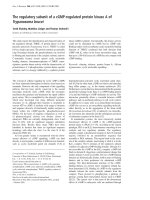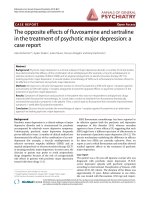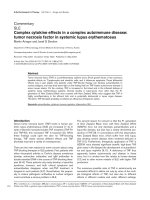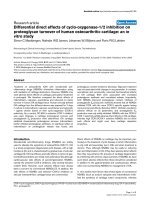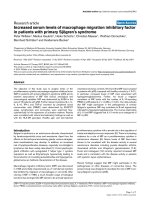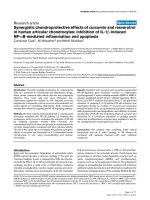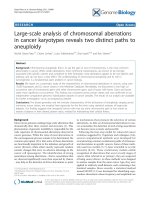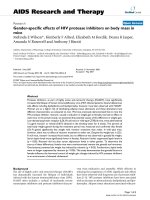Báo cáo y học: "Circadian phase-shifting effects of a laboratory environment: a clinical trial with bright and dim light" ppsx
Bạn đang xem bản rút gọn của tài liệu. Xem và tải ngay bản đầy đủ của tài liệu tại đây (609.1 KB, 9 trang )
BioMed Central
Page 1 of 9
(page number not for citation purposes)
Journal of Circadian Rhythms
Open Access
Research
Circadian phase-shifting effects of a laboratory environment: a
clinical trial with bright and dim light
Shawn D Youngstedt*
1
, Daniel F Kripke
2
, Jeffrey A Elliott
2
and
Katharine M Rex
2
Address:
1
Department of Exercise Science, Norman J. Arnold School of Public Health, University of South Carolina, Columbia, SC 29208, USA
and
2
Department of Psychiatry and Sam and Rose Stein Institute for Research on Aging, University of California, San Diego, USA
Email: Shawn D Youngstedt* - ; Daniel F Kripke - ; Jeffrey A Elliott - ;
Katharine M Rex -
* Corresponding author
Abstract
Background: Our aims were to examine the influence of different bright light schedules on mood,
sleep, and circadian organization in older adults (n = 60, ages 60–79 years) with insomnia and/or
depression, contrasting with responses of young, healthy controls (n = 30, ages 20–40 years).
Methods: Volunteers were assessed for one week in their home environments. Urine was
collected over two 24-hour periods to establish baseline acrophase of 6-sulphatoxymelatonin
(aMT6s) excretion. Immediately following home recording, volunteers spent five nights and four
days in the laboratory. Sleep periods were fixed at eight hours in darkness, consistent with the
volunteers' usual sleep periods. Volunteers were randomly assigned to one of three light
treatments (four hours per day) within the wake period: (A) two hours of 3,000 lux at 1–3 hours
and 13–15 hours after arising; (B) four hours of 3,000 lux at 6–10 hours after arising; (C) four
hours of dim placebo light at 6–10 hours after arising. Lighting was 50 lux during the remainder of
wakefulness. The resulting aMT6s acrophase was determined during the final 30 hours in the
laboratory.
Results: Neither mood nor total melatonin excretion differed significantly by treatment. For the
three light treatments, significant and similar phase-response plots were found, indicating that the
shift in aMT6s acrophase was dependent upon the circadian time of treatment. The changes in
circadian timing were not significantly correlated to changes in sleep or mood.
Conclusion: The trial failed to demonstrate photoperiodic effects. The results suggest that even
low levels of illumination and/or fixed timing of behavior had significant phase-shifting effects.
Introduction
Older adults have an altered synchronization of circadian
rhythms compared to young adults [1-4]. Circadian mis-
alignment of rhythms or malsynchronization might con-
tribute to many age-related disorders of sleep or mood, as
has been observed in conjunction with shift-work and jet
lag.
It has been hypothesized that age-related circadian mal-
synchronization might be explained by reduced exposure
Published: 09 September 2005
Journal of Circadian Rhythms 2005, 3:11 doi:10.1186/1740-3391-3-11
Received: 30 August 2005
Accepted: 09 September 2005
This article is available from: />© 2005 Youngstedt et al; licensee BioMed Central Ltd.
This is an Open Access article distributed under the terms of the Creative Commons Attribution License ( />),
which permits unrestricted use, distribution, and reproduction in any medium, provided the original work is properly cited.
Journal of Circadian Rhythms 2005, 3:11 />Page 2 of 9
(page number not for citation purposes)
to light and other zeitgebers in older adults. However,
studies have found that, when compared to young adults,
older adults are exposed to at least as much bright light
(e.g., in San Diego [5,6]) and to environmental and social
zeitgebers of even greater regularity [7]. Nonetheless, it is
likely that retinohypothalamic neurotransmission of light
to the SCN is compromised in older adults due to glau-
coma, macular degeneration, senile miosis, and other eye
problems [8,9]. Moreover, age-related neurodegeneration
of the suprachiasmatic nuclei (SCN) [10] could make the
SCN less responsive to light in older adults. Preliminary
evidence suggests that aging subjects may display smaller
phase shifts to light stimuli [11,12]. Thus, older adults
might require increased exposure to light or other syn-
chronizers for adequate circadian entrainment.
Although light exposure is apparently the most important
circadian synchronizer, careful regulation of the sleep-
wake schedule [13,14], as well as physical activity [15,16]
and social interaction [17], can also influence circadian
timing. These non-photic stimuli can produce effects
added to those produced by light alone.
Appropriately timed exposure to bright light and other
zeitgebers might help correct circadian malsynchroniza-
tion and alleviate sleep and mood problems that are com-
mon in older adults. Evidence indicates that light can also
have photoperiodic effects on the organization of the
human circadian system [18]. The main aims of this study
were: (1) to contrast the influences of different bright light
schedules on circadian and photoperiodic organization in
older adults with insomnia and/or depression and in
young, healthy controls; (2) to examine whether circadian
"phase correction", i.e., shifting the circadian system to
more normal timing, could improve sleep or mood
among the older adults. However, since differing light
treatments produced similar results, this presentation will
emphasize the phase changes produced.
Methods
Subjects
Volunteers were 72 older adults (49 women, 23 men) ages
60–79 years, who were selected for complaints of insom-
nia and/or depression. The volunteers reported that their
symptoms were of sufficient severity to warrant treatment.
Volunteers were screened for freedom from melatonin-
altering medications (with few exceptions), and the
absence of acute health problems. A control group of 30
(n = 15 women, 15 men) young, healthy volunteers ages
20–40 years was studied in parallel. Volunteers signed
their consent to participate in the study as approved by the
UCSD Institutional Review Board.
Home Baseline Procedures
Volunteers were first assessed for five-seven days in their
home environments. Volunteers were asked to maintain
their usual sleep and lifestyle habits during this time.
Baseline Urine Collection
Over two 24–30-hour periods (usually days three-four
and six-seven at home), volunteers collected their urine
samples approximately every two hours during wakeful-
ness plus all voidings during the nighttime sleep period.
Volunteers recorded the timing and volume of each col-
lection, and stored 2-ml samples in their freezers. The
samples were subsequently transferred to a laboratory -
70°C freezer.
Baseline Sleep Assessment
An actigraph with minute-by-minute recordings of wrist
activity and illumination was worn throughout home
recording, except for short removals for bathing, etc.
(Actillume I, Ambulatory Monitoring, Ardsley, New
York). The nocturnal sleep periods were determined from
actigraphic sleep and illumination recording combined
with daily sleep diary data. Objective sleep was scored
with a validated algorithm associating wrist movement
with electroencephalographically-recorded sleep [19]. For
each night, actigraphically-assessed sleep onset latency
(SOL), total sleep time (TST), time spent awake after ini-
tial sleep onset (WASO), and sleep efficiency were deter-
mined. Each morning, subjective ratings of minutes of
TST and WASO, and a 100 mm visual analogue rating of
insomnia were also recorded. Mean baseline sleep levels
were calculated, and have been reported previously [1].
Baseline Mood Assessment
The subjects' depressed moods were assessed on two days
(usually days three and six) with the Center for Epidemi-
ologic Studies-Depression (CES-D) questionnaire, which
consists of 20 questions with four-point Likert responses
(possible range: 0 to 60) [20]. The questionnaire was com-
pleted four hours after arising. Mean baseline CES-D was
calculated. These data have been reported previously [1].
Laboratory Procedures
Immediately following home recording, volunteers spent
five nights and four days in the Circadian Pacemaker Lab-
oratory at UCSD, arriving on Sunday evening two hours
before bedtime, and leaving on Friday morning after aris-
ing (Figure 1). Each volunteer stayed in an individual
apartment equipped with a bed, comfortable chair, televi-
sion, kitchen, and private shower and bathroom facilities.
Volunteers were provided with food of their own choos-
ing (except for alcohol and caffeine) and were free to pre-
pare and eat food ad libitum during the wake periods.
Journal of Circadian Rhythms 2005, 3:11 />Page 3 of 9
(page number not for citation purposes)
Sleep periods were fixed at eight hours, timed to corre-
spond approximately with each volunteer's average
home-recorded sleep schedule. Illumination levels were
<0.5 lux during the sleep periods and ≤50 lux average in
the horizontal direction at eye level during the 16-hour
periods of wakefulness (except during the bright light
treatments, described below). Sleep was discouraged dur-
ing the wake periods with the aid of video monitoring,
though some volunteers fell asleep for brief time periods
(approximately two-five minutes). Volunteers were per-
mitted one cup of coffee during the first four hours after
arising. Vigorous exercise was not permitted, but light cal-
isthenics and slow walking were allowed. Otherwise, vol-
unteers were free to do what they wished during the wake
periods, i.e., watch TV, receive visitors, read, etc. Because
priority was placed on assuring that the laboratory experi-
ence did not trigger more severe depression, the labora-
tory staff made special efforts to help the volunteers feel
comfortable and engaged in the laboratory experience. It
was not uncommon for staff to spend several hours per
day playing board games or chatting with a volunteer.
Light Treatments
Volunteers were randomly assigned to one of three light
treatments, which were administered for four hours dur-
ing each of the four days of the experiment (Figure 2). The
light treatments were administered via overhead cool-
white fluorescent lights, providing relatively even light
levels at eye-level throughout the laboratory rooms.
Laboratory protocolFigure 1
Laboratory protocol. Arriving two hours before their
usual bedtime, subjects spent five nights and four days in the
laboratory. This figure displays the time of urine collections
(shown in red), which began after the last voiding before
morning (most participants urinated during the night) and
continued through the final morning voiding after the next
consecutive night, slightly more than 24 hours.
Experimental Light TreatmentsFigure 2
Experimental Light Treatments. Volunteers were ran-
domly assigned to three four-hour light treatments (detailed
in this figure) administered on four consecutive days against a
background of <0.5 lux during eight-hour sleep periods and
50 lux during 16-hour wake periods. Treatment A was two
hours at 3,000 lux from 1–3 hours and 13–15 hours after
arising. Treatment B was four hours at 3,000 lux from 6–10
hours after arising. Treatment C was four hours of dim red
light placebo from 6–10 hours after arising. Note that the
center of each treatment was eight hours after arising, and
the abscissa was hours after usual wake time.
Journal of Circadian Rhythms 2005, 3:11 />Page 4 of 9
(page number not for citation purposes)
Treatment A consisted of two hours of bright light (3,000
lux in the direction of gaze) at one-three hours after aris-
ing, as well as at three to one hours before bedtime. The
3000 lux portion of Treatment A was designed to resemble
a skeleton LD14:10-long photoperiod. An LD16:8 skele-
ton might have had greater photoperiodic effect, but there
was concern that LD16:8 might disturb sleep excessively.
Treatment B consisted of four hours of bright light (3,000
lux) in the middle of the wake period, i.e., six-ten hours
after awakening. The bright portion of Treatment B might
resemble a short LD4:20 photoperiod, to the extent that
the surrounding 50 lux treatment was photoperiodically
ineffective. Also, bright light in Treatment B would be
expected to fall in a relatively insensitive zone of the light
phase response curve. Treatment C, the control treatment,
involved four hours of placebo dim red light (1 lux) given
six-ten hours after arising. With no bright light, it was
expected that Treatment C would have little circadian
effect. All treatments were superimposed upon the 16
th
hour of background illumination of 50 lux. As observed in
Figure 2, the center of timing of each light treatment was
precisely eight hours after arising.
Volunteers were given standardized instructions designed
to minimize potential differences in expectancy for bene-
ficial effects of the treatments. After the volunteers were
assigned to the treatments, expectancy for improvement
in mood and sleep during the experiment was assessed via
100 mm visual analogue scales.
Urine Collection
As during home recording, urine was collected every two
hours during wake and for any nighttime voidings. The
collection time was over two periods of approximately 30
hours: from the last voiding during night one until wake-
time on day two, and from the last voiding on night four
until wake-time at the end of night five (see Figure 1).
Sleep Assessment
For each laboratory sleep period, measures of SOL, TST,
WASO, and sleep efficiency were recorded and scored
with standard polysomnographic procedures [21] as well
as with actigraphy. In addition, subjective measures of
TST, WASO, and insomnia were recorded each morning
with diaries, as during home recording.
Mood Assessment
On day four, the subjects' depressed moods were assessed
with the CES-D [20] four hours after arising. This repre-
sented the final CES-D score.
Assays
Urinary concentrations of 6-sulphatoxymelatonin
(aMT6s), the primary metabolite of melatonin, were
assayed with a highly specific RIA assay developed by
Aldous and Arendt (ALPCO, Ltd., Windham, NH, USA)
[22]. Sensitivity of the RIA technique was <0.2 ng/mL.
Intra- and inter-assay coefficients of variation were 3.3%
and 6.7%, respectively.
Data Analysis
Circadian Phase Assessment and Exclusion of Data
An investigator (JAE) used a four-point ranking system to
rate the visual "quality" of the aMT6s excretion profiles:
"excellent", "good", "poor", or "insufficient data". The rat-
ings were based, for example, on whether the profiles had
the expected patterns of transitions between daytime and
nighttime levels, or whether higher or irregular baseline
levels or abrupt spikes were observed. Artifacts might be
attributable to many factors, including incomplete void-
ing of the bladder and inaccuracies in recording urinary
volume or timing. Only data that were rated "excellent" or
"good" were used for fitting 24-hour cosines to the aMT6s
excretion data for estimation of aMT6s acrophase (24-
hour fitted peak). Since estimation of circadian phase shift
required assessment of both baseline and final circadian
phases, the present analyses included only volunteers
with aMT6s excretion profiles rated "excellent" or "good"
for both baseline and final assessments. This reduced the
number of older volunteers included in the analysis to 60,
whereas aMT6s data could be analyzed in all 30 of the
young volunteers.
Baseline aMT6s acrophase was estimated from data of
the best quality. If both aMT6s profiles were of sufficient
quality, a 24-hour cosine was fit across data for both days.
If only one of the aMT6s profiles was of sufficient quality,
the cosine was fit only for this day (e.g., Figure 3). If nei-
ther home profile was of sufficient quality, then baseline
phase was defined by the aMT6s acrophase derived from
day one in the laboratory (if this profile was of sufficient
quality). In profiles of good quality, the home and first
laboratory acrophases only differed, on average, by 0.03
hours. Baseline aMT6s acrophase was compared across
treatment and age group via 3 × 2 ANOVA. Final aMT6
acrophase was determined from urinary data collected
during the final 24–30 hours in the laboratory. The aMT6s
parameters reflected the melatonin profile in the presence
of light masking, both at home and in the laboratory.
Treatment Phase-Shifting Effects
According to convention, circadian phase shifts following
the light treatments were calculated by subtracting the
final aMT6s acrophase from the baseline aMT6s acro-
phase. Thus, negative and positive shifts indicated phase
delays and phase advances, respectively. Phase-response
plots were derived by plotting resultant circadian phase
shifts (y-axis) against the circadian timing of the light
treatments (A, B, or C) relative to the subjects' baseline
aMT6s acrophases. The phase reference used for all light
Journal of Circadian Rhythms 2005, 3:11 />Page 5 of 9
(page number not for citation purposes)
treatments was the center of the four-hour treatment,
which was also the center of the 16-hour period of back-
ground illumination and wakefulness. Within the
restricted phase range, the phase response data was suffi-
ciently linear for slopes and elevations of linear regression
lines to be compared via ANOVA, using procedures
described by Zar [23].
Circadian Abnormality and Phase Correction
Two measures of circadian misalignment were calculated.
First, since our previous analysis of this group indicated
that sleep was best when the aMT6s acrophase coincided
approximately with mid-sleep (i.e., mid-point between
lights out and final time of awakening) [1], circadian
malsynchronization was defined as the absolute phase
angle (h) between an individual's aMT6s acrophase and
his/her mid-sleep. Second, circadian phase dispersion
was defined as the absolute number of hours between an
individual's aMT6s acrophase and the median aMT6s
acrophase for his/her age group. These measures were cal-
culated for both baseline and final aMT6s acrophase data.
Baseline measures of circadian malsynchronization and
phase dispersion were compared via 3 × 2 treatment-by-
age group ANOVAs. Two measures of circadian phase
correction were defined by the extent to which circadian
malsynchronization and phase dispersion were decreased
from baseline to final phase assessment. These changes
were compared with 3 × 2 × 2 light treatment-by-age
group (older vs. young)-by-time (baseline vs. final)
ANOVAs.
Treatment Effects on Mood and Sleep
Mean home baseline CES-D data was compared with CES-
D responses during the final day in the laboratory. The
laboratory actigraphic data was regarded as the most rele-
vant sleep data to compare to baseline, because acti-
graphic data allowed comparisons of objective home
versus laboratory sleep. To assess changes in sleep associ-
ated with the treatments, mean home actigraphic data was
compared with mean actigraphic data from the final two
nights in the laboratory. Likewise, mean home sleep diary
data was compared with the mean diary reports of the last
two nights in the laboratory. Analysis of polysomono-
graphic data compared data averaged across the first two
nights in the laboratory to the last two nights in the labo-
ratory. Changes in mood and sleep following the treat-
ments were assessed via 3 × 2 × 2 treatment-by-age group-
by-time ANOVAs.
Association of Phase Correction with Changes in Mood and Sleep
The association of changes in circadian malsynchroniza-
tion and phase dispersion with changes in sleep and
mood following treatment were assessed in two ways.
First, Spearman rank-order correlations were calculated.
Second, t-tests compared changes in sleep and mood
between groups that had phase correction versus groups
that had no phase correction (i.e., had no change or
increases in malsynchronization and phase dispersion).
Results
Circadian Timing
As measured by Actillume in the week before entering the
laboratory, the center of the sleep periods averaged 03:20
at home. In the laboratory, measurments mid-dark aver-
aged 03:11 (a small but significant difference: p < 0.025).
As measured by Actillume, the median mesor illumina-
tion (24-hour fitted mean) was 478 lux at home and 349
lux, 381 lux, and 30 lux respectively for treatments A, B,
and C in the laboratory. However, the acrophases of 24-
hour Actillume illumination measured in lux were 13:09
at home and 15:58 in the laboratory, reflecting the ten-
dency of bright daylight exposures at home to occur
before mid-wake.
Baseline and Final aMT6s Acrophase Data
The aMT6s data for the older and young volunteers are
displayed in Table 1. No significant treatment, age group,
or treatment-by-age group interaction effects were found
for aMT6s acrophase data. Likewise, no significant treat-
ment effects were observed for the final laboratory aMT6s
Determining Urinary aMT6s AcrophaseFigure 3
Determining Urinary aMT6s Acrophase. An example
of analyzing urinary aMT6s is shown. The yellow area shows
that the excretion rate of aMT6s from one voiding to the
next was associated with each interval between voidings. The
red line shows that a best-fitting cosine curve was estimated.
The salmon dotted line indicates the mesor (the mean level
of the fitted cosine). The rose arrow shows that the ampli-
tude of the rhythm is the level of the peak of the fitted cosine
above the mesor. The lavender arrow shows that the acro-
phase is the time of the peak of the fitted cosine referenced
to the prior midnight.
Journal of Circadian Rhythms 2005, 3:11 />Page 6 of 9
(page number not for citation purposes)
mesor or the estimated duration of aMT6s secretion (data
not shown).
Treatment Phase-Shifting Effects
Phase responses to the treatments are displayed in Figure
4. Significant linear regressions associating the circadian
timing of the light treatments with shifts in aMT6s acro-
phase were found for each treatment. However, there was
no significant difference between treatments in the slopes
or in the origins of the regression lines. Across all treat-
ments, there was a significant mean delay in aMT6s
acrophase from baseline to final assessment (45 min ± 15
min SEM, t = 3.04, p = 0.003); however, there were no sig-
nificant treatment-by-time or age group-by-time interac-
tion effects.
Circadian Abnormality and Phase Correction
As compared to younger subjects, at baseline the older
subjects had more circadian malsynchronization [t(1,88)
= 4.57, p < 0.001] and greater circadian phase dispersion
[t(1,88) = 2.50, p = 0.014]. However, there were no signif-
icant treatment or treatment-by-age group differences
between these variables at baseline (before treatment).
There was a significant increase in circadian malsynchro-
nization from baseline to final assessment [F(1,88) = 8.5,
p = 0.004] (Figure 5), indicating the delays in aMT6s acro-
phase. However, there was no significant treatment-by-
time or age group-by-time interaction in this effect. Circa-
dian phase dispersion showed no significant change over
time (Figure 6), and no significant treatment-by-time or
age group-by-time interaction.
Treatment Effects on Mood and Sleep
Volunteers reported equal expectancy for improvements
in sleep and mood following each treatment. A significant
reduction in the CES-D from baseline to final measure-
ment was found [F(1,82) = 13.8, p < 0.001]. There was no
treatment-by-time interaction for CES-D. A near-signifi-
cant age-group-by-time effect was found for CES-D
(F(1,82) = 3.7, p = 0.058]. CES-D was reduced from 15.4
± 1.1 to 11.4 ± 1.0 in the older group and from 9.1 ± 1.5
to 8.0 ± 1.3 in the younger group.
In actigraphic data, significantly less TST, lower sleep effi-
ciency, and greater WASO were found in the older volun-
teers as compared to the young volunteers. A significant
age group-by-time effect for actigraphic TST was mediated
by slight increases from baseline to final assessment in the
older group (from 334.3 ± 8.8 min to 339.3 ± 7.6 min)
but decreases in the young group (from 450.8 ± 9.4 min
to 367.6 ± 7.7 min). No significant treatment or treat-
ment-by-time effects for actigraphic sleep were found.
Table 1: aMT6s acrophase and measures of circadian malsynchronization and phase dispersion in older (n = 60, ages 60–79) and young
volunteers (n = 30, ages 20–40), mean and SE.
Age Group Baseline aMT6s
Acrophase
Final aMT6s
Acrophase
Baseline Circadian
Malsynch.
Final Circadian
Malsynch.
Baseline Circadian
Dispersion
Final Circadian
Dispersion
Older 4.01 ± 0.25 4.68 ± 0.28 1.57 ± 0.16 2.19 ± 0.19 1.53 ± 0.15 1.60 ± 0.18
Young 4.14 ± 0.23 5.07 ± 0.28 0.69 ± 0.11 1.09 ± 0.23 1.04 ± 0.12 1.10 ± 0.20
Phase Response Plots for each Light TreatmentFigure 4
Phase Response Plots for each Light Treatment.
Shown are the shifts in aMT6s acrophase, which varied signif-
icantly for each treatment, as a function of the circadian tim-
ing of the light treatments, defined as the center of treatment
(eight hours after arising) relative to the aMT6s acrophase at
baseline.
Journal of Circadian Rhythms 2005, 3:11 />Page 7 of 9
(page number not for citation purposes)
In sleep diary measures, significantly less TST and signifi-
cantly greater WASO and insomnia (100 mm visual ana-
logue) were found for the older volunteers in comparison
to the young volunteers. A significant age group-by-time
interaction for insomnia was mediated by decreases in the
older group (from 44.7 ± 1.9 mm to 39.5 ± 2.8 mm) and
increases in the young group (from 15.3 ± 2.6 mm to 19.8
± 3.5 mm.) No significant treatment or treatment-by-time
effects for these variables was found.
The older group had significantly less polysomnographic
TST and more WASO compared with the young group.
However, no significant age group contrasts by time,
treatment, or treatment-by-time interaction were found
for polysomnographic sleep.
Correlations of "Phase Correction" with Changes in Mood
and Sleep
Changes in circadian malsynchronization and phase dis-
persion were not significantly correlated with changes in
mood or sleep. Moreover, changes in mood and sleep
were not different between individuals who experienced
decreases in circadian malsynchronization or decreases in
phase dispersion following treatment compared with
those who experienced no phase correction.
Discussion
Surprisingly, no significant contrasts between the three
light treatments were demonstrated for melatonin or
actigraphic parameters, sleep, or mood, nor could changes
in circadian misalignment be associated with distur-
bances of sleep or mood. Perhaps a longer period of ran-
domized treatment would have resulted in greater
contrasts, but significant effects of bright light treatment
on mood have been demonstrated with treatment of one
week or less, and it is not currently clear that treatment
beyond one week produces any greater benefit [24]. Prob-
ably, 10,000 lux would have been slightly more effective
than 3,000 lux. Urine collections of aMT6s are not the
most precise method of estimating melatonin timing, but
they were considered less burdensome on the depressed
participants than alternative methods.
Significant phase-responses were evident after each labo-
ratory treatment. The average delay in aMT6s acrophase in
the laboratory was probably due to the dimmer and later
illumination timing in the laboratory as compared to the
home situation, because illumination peaked before mid-
wake at home, mid-wake averaging well after noon. The
Circadian malsynchronization at baseline and final assessmentFigure 5
Circadian malsynchronization at baseline and final
assessment. Shown is circadian malsynchronization, defined
as the absolute phase angle (mean ± SE hours) between
aMT6 acrophase and mid sleep, determined at baseline and
following the light treatments. A significant increase in mal-
synchronization was found.
Phase dispersion at baseline and final assessmentFigure 6
Phase dispersion at baseline and final assessment.
Shown is phase dispersion, defined as the absolute number of
hours (mean ± SE) between aMT6s acrophase and the
median aMT6s acrophase, determined at baseline and follow-
ing the treatments.
Journal of Circadian Rhythms 2005, 3:11 />Page 8 of 9
(page number not for citation purposes)
similarity in phase responses between the two bright light
treatments was consistent with previous studies,
suggesting that phase-shifting effects may be estimated
from the timing center of light treatments [25,26]. How-
ever, it might have been predicted that treatment A would
fall on a more active portion of the phase-response curve
than treatment B. Also, the remarkable similarity in the
phase responses for the dim placebo treatment in compar-
ison to the bright light treatments was unexpected. Dose-
response studies have indicated that phase-shifting effects
of light are related to cube-root [27] or logistic functions
[28] of illumination, either of which would predict that
the bright light treatments (3,000 lux) were at least two-
fold stronger than the placebo treatment (50 lux). None-
theless, it appears that the dim placebo and bright light
treatments had similar phase-shifting potency in the
present protocol.
Our phase shift responses could be explained by non-
photic zeitgebers, including the imposed sleep-wake
cycle, social cues, and activity/rest. There is evidence that
the sleep-wake cycle is a potent zeitgeber; this effect may
be independent of the light-dark cycle [13,29,30]. Com-
bining a fixed sleep-wake routine, with appropriately
timed bright light, produces additive phase-shifting effects
[13,29]. Both classic and recent research has shown that
social interaction can be a significant zeitgeber
[17,29,31,32].
Particular procedures used in the present study might
have facilitated non-photic entrainment. For example,
during the baseline week, volunteers in the present study
were asked to maintain their usual sleep-wake and daily
routines. These routines were often quite erratic, which
might have rendered the circadian system more sensitive
to the fixed high amplitude rest/activity schedule in the
laboratory. In other studies, subjects have been required
to maintain more rigid baseline sleep-wake schedules
prior to experimental treatment [27,28].
The degree of social interaction between the volunteers
and staff in the present study was greater than that which
was permitted in many other studies. Laboratory social
interaction was designed both to provide comfort and to
help monitor the volunteers for safety. Social interaction
may have significant independent zeitgeber effects, and
can act synergistically with light exposure. Clinically, it is
relevant to examine light effects in the presence of social
interaction.
The equivalent reduction in depression following each
treatment did not support the prediction of greater antide-
pressant effects with bright light. Possibly the influence of
light could be attenuated by the kind care the volunteers
received in the laboratory, the social interactions, and pla-
cebo effects. Moreover, the light treatment was for fewer
days than that employed in the majority of clinical trials
of bright light treatment [24], so an insufficient duration
might explain the lack of significant effect. An insufficient
duration or intensity of light treatment might also explain
the failure to observe photoperiodic effects on the dura-
tion of aMT6s excretion.
Another unexpected finding was the significant increase
in circadian malsynchronization following the bright
light treatments. Phase dispersion also showed a non-sig-
nificant increase. The phase-response plots indicated that
the treatments resulted in "over-corrections" of circadian
phase. Volunteers with the most advanced body clocks in
reference to sleep at baseline (whose light treatment was
therefore centered more than 12 hours after the aMT6s
acrophase) demonstrated large phase delays as shown in
Figure 4. Conversely, those most delayed in reference to
sleep at baseline experienced large phase advances. The
corrections were often greater than the amounts of initial
phase abnormality, contrary to hypothesis. Also, reduc-
tions in circadian malsynchronization or phase disper-
sion (phase correction) were not correlated with
improvements in sleep and mood. Chronic mood and
sleep problems associated with circadian malsynchroniza-
tion might be difficult to correct in such a short period of
time, although we had expected to find measurable
responses.
Conclusion
Consistent with previous studies, compared to young
adults, older adults had significantly greater circadian
malsynchronization and phase dispersion. Significant
and remarkably similar phase-responses were found for
each of the three light treatment schedules. The results
suggest that low levels of illumination and/or fixed timing
of behavior had significant circadian phase-shifting
effects. The large phase-shifts resulted in a significant
increase in circadian malsynchronization, rather than
phase correction. Moreover, phase correction was not sig-
nificantly associated with improvements in sleep or
mood.
Competing interests
The author(s) declare that they have no competing
interests.
Authors' contributions
SDY supervised the data collection, subject recruitment,
data analysis, and drafting the manuscript.
DFK conceived of the study and was a principal investiga-
tor, screened the subjects, and assisted in data analysis and
drafting of the manuscript.
Publish with Bio Med Central and every
scientist can read your work free of charge
"BioMed Central will be the most significant development for
disseminating the results of biomedical research in our lifetime."
Sir Paul Nurse, Cancer Research UK
Your research papers will be:
available free of charge to the entire biomedical community
peer reviewed and published immediately upon acceptance
cited in PubMed and archived on PubMed Central
yours — you keep the copyright
Submit your manuscript here:
/>BioMedcentral
Journal of Circadian Rhythms 2005, 3:11 />Page 9 of 9
(page number not for citation purposes)
JAE assisted in designing the study and drafting the man-
uscript and performed the aMT6s assays.
KMR assisted in designing the study, in laboratory data
collection, and in drafting the manuscript.
Acknowledgements
This study was supported by AG12364, and HL71560. Raul S. Sepulveda,
MD, Patricia Fahme, Yvonne C. Alcala, Julian Smith, MD, and Anthony C.
Cress assisted with this study. The study was performed in Dr. Kripke's lab-
oratory in the Department of Psychiatry and Sam and Rose Stein Institute
for Research on Aging at UCSD.
References
1. Youngstedt SD, Kripke DF, Elliott JA, Klauber MR: Circadian
abnormalities in older adults. J Pineal Res 2001, 31:264-272.
2. Lushington K, Lack L, Kennaway DJ, Rogers N, van den Heuvel C,
Dawson D: 6-sulfatoxymelatonin excretion and self-reported
sleep in good sleeping controls and 55–80-year-old
insomniacs. J Sleep Res 1998, 7:75-83.
3. Weitzman ED, Moline ML, Czeisler CA, Zimmerman JC: Chronobi-
ology of aging: temperature, sleep-wake rhythms and
entrainment. Neurobiol Aging 1982, 3:299-309.
4. Kripke DF, Youngstedt SD, Elliott JA, Tuunainen A, Rex KM, Hauger
RL, et al.: Circadian phase in adults of contrasting ages. Chrono-
biol Int in press.
5. Youngstedt SD, Kripke DF, Elliott JA, Baehr EK, Sepulveda RS: Light
exposure, sleep quality, and depression in older adults. In Bio-
logic Effects of Light 1998 Edited by: Holick MF, Jung EG. Boston: Klu-
wer Academic Publishers; 1999:427-435.
6. Jean-Louis G, Kripke DF, Ancoli-Israel S, Klauber MR, Sepulveda RS:
Sleep duration, illumination, and activity patterns in a popu-
lation sample: effects of gender and ethnicity. Biol Psychiat
2000, 47:921-927.
7. Monk TH, Reynolds CFI, Kupfer DJ, Hoch CC, Carrier J, Houck PR:
Differences over the life span in daily life-style regularity.
Chronobiol Intl 1997, 14:295-306.
8. Gaddy JR, Rollag MD, Brainard GC: Pupil size regulation of
threshold of light-induced melatonin suppression. J Clin Endo-
crinol Metab 1993, 77:1398-1401.
9. Brainard GC, Gaddy JR, Ruberg FM, Barker FM, Hanifin JP, Rollag MD:
Ocular mechanisms that regulate the human pineal gland Edited by:
Moller M, Pevet P. London: John Libby & Company Ltd; 1994:415-432.
10. Swaab DF, Fliers E, Partiman TS: The suprachiasmatic nucleus of
the human brain in relation to sex, age and senile dementia.
Brain Res 1985, 342:37-44.
11. Zhang Y, Kornhauser JM, Zee PC, Mayo KE, Takahashi JS, Turek FW:
Effects of aging on light-induced phase-shifting of circadian
behavioral rhythms, Fos expression and CREB phosphoryla-
tion in the hamster suprachiasmatic nucleus. Neurosci 1996,
70:951-961.
12. Klerman EB, Duffy JF, Dijk D-J, Czeisler CA: Circadian phase
resetting in older people by ocular bright light exposure. J
Invest Med 2001, 49:30-40.
13. Eastman CI, Martin SK: How to use light and dark to produce
circadian adaptation to night shift work. Ann Med 1999,
31:87-98.
14. Horowitz TS, Cade BE, Wolfe JM, Czeisler CA: Efficacy of bright
light and sleep/darkness scheduling in alleviating circadian
maladaptation to night work. Am J Physiol Endocrinol Metab 2001,
281:E384-E391.
15. Youngstedt SD, Kripke DF, Elliott JA, Huegel GO, Rex KM: Exercise
phase-response curves in young and older adults. Program
Abstracts Eighth Meeting Soc Res Biol Rhythms 2002:110.
16. Buxton OM, Lee CW, L'Hermite-Baleriaux M, Turek FW, Van Cauter
E: Exercise elicits phase shifts and acute alterations of mela-
tonin that vary with circadian phase. Am J Physiol Reg Integ Comp
Physiol 2003, 284:R714-R724.
17. Honma K, Hashimoto S, Nakao M, Honma S: Period and phase
adjustments of human circadian rhythms in the real world. J
Biol Rhythms 2003, 18:261-270.
18. Wehr TA: Photoperiodism in humans and other primates:
Evidence and implications. J Biol Rhythms 2001, 16:348-364.
19. Jean-Louis G, Kripke DF, Cole RJ, Assmus JD, Langer RD: Sleep
detection with an accelerometer actigraph: comparisons
with polysomnography. Physiol Behav 2001, 72:21-28.
20. Radloff LS: The CES-D scale: A self-report depression scale for
research in the general population. Applied Psychol Measur 1977,
1:385-401.
21. Rechtschaffen A, Kales A: A Manual of Standardized Terminology, Tech-
niques and Scoring System for Sleep Stages of Human Subjects Los Ange-
les: Brain Information Service, Brain Research Institute, UCLA; 1968.
22. Aldous M, Arendt J: Radioimmunoassay of 6-sulphatoxy mela-
tonin using an iodinated tracer. Ann Clin Biochem 1988,
25:298-303.
23. Zar JH: Biostatistical Analysis Englewood Cliffs, N.J.: Prentice-Hall;
1984.
24. Tuunainen A, Kripke DF, Endo T: Light Therapy for Non-Sea-
sonal Depression (Cochrane Review). The Cochrane Library
2004.
25. Czeisler CA, Kronauer RE, Allan JS, Duffy JF, Jewett ME, Brown EN,
et al.: Bright light induction of strong (type 0) resetting of the
human circadian pacemaker. Science 1989, 244:1328-1333.
26. Daan S: Colin Pittendrigh, Jurgen Aschoff, and the natural
entrainment of circadian systems. J Biol Rhythms 2000,
15:195-207.
27. Boivin DB, Duffy JF, Kronauer RE, Czeisler CA: Dose-response
relationships for resetting of human circadian clock by light.
Nature 1996, 379:540-542.
28. Zeitzer JM, Dijk D-J, Kronauer RE, Brown EN, Czeisler CA: Sensi-
tivity of the human circadian pacemaker to nocturnal light:
Melatonin phase resetting and suppression. J Physiol (London)
2000, 526:695-702.
29. Wever RA: The Circadian System of Man: Results of Experiments Under
Temporal Isolation New York: Springer-Verlag; 1979.
30. Eastman CI, Miescke KJ: Entrainment of circadian rhythms with
26-h bright light and sleep-wake schedules. Am J Physiol Regula-
tory Integrative Comp Physiol 1990, 259:R1189-R1197.
31. Aschoff J, Fatranska M, Giedke H, Doerr P, Stamm D, Wisser H:
Human circadian rhythms in continuous darkness: entrain-
ment by social cues. Science 1971, 171:213-215.
32. Honma K, Honma S, Nakamura K, Sasaki M, Endo T, Takahashi T: Dif-
ferential effects of bright light and social cues on reentrain-
ment of human circadian rhythms. Am J Physiol 1995,
268:R528-35.


